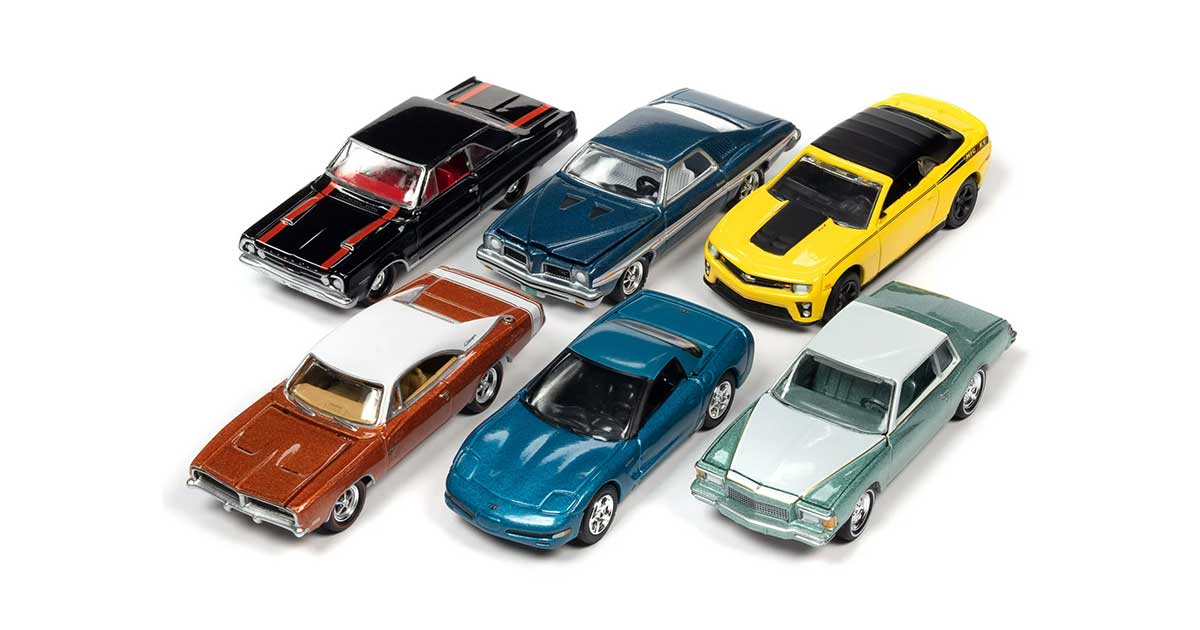Caring for Your Diecast Collection: Cleaning and Maintenance Tips
Master the art of preserving your miniature treasures
Diecast models represent more than mere collectibles—they embody precision engineering and artistry in miniature form. As passionate collectors ourselves at Hearns Hobbies, we understand that maintaining these precious pieces requires both dedication and expertise. Whether you're safeguarding cherished classics or contemporary masterpieces, proper care ensures your collection maintains its splendour and value for generations to come.
| Diecast Care at a Glance | |
|---|---|
| Essential Tools | Professional cleaning supplies, specialised brushes and cleaners, protective equipment |
| Maintenance Needs | Regular dusting, detailed cleaning, protective storage, display solutions |
| Protection Methods | High-quality display cases, climate control, UV protection |
| Skill Requirements | Suitable for all collectors, from beginners to advanced enthusiasts |
Ready to discover the secrets of professional diecast care? Explore our complete range of model tools and preservation supplies to keep your collection in pristine condition.
Why Proper Maintenance Matters
In the world of collecting, diecast models represent more than mere miniatures—they are intricate works of art that demand meticulous attention. Each diecast model tells its own story, whether it's a cherished vintage piece or a contemporary masterpiece, making proper maintenance not just a necessity but a crucial aspect of preservation. The investment in both time and resources to maintain these pieces properly ensures they retain their value and continue to bring joy to collectors for generations.
Environmental factors pose significant threats to your collection's integrity. Dust accumulation can scratch delicate surfaces, while fluctuating humidity levels may lead to oxidation of metal components. UV exposure, often overlooked, can cause irreversible fading to paint finishes and deterioration of rubber elements. Regular maintenance using appropriate cleaning supplies helps combat these challenges, preserving both the aesthetic appeal and market value of your collection.

Professional display cases protect your investment while showcasing your collection

Intricate details require special care and attention
Essential Cleaning Tools
Achieving professional-level care for your diecast collection requires a carefully curated selection of tools. The right equipment not only ensures effective cleaning but also prevents accidental damage during maintenance. Our extensive experience has shown that investing in quality model tools pays dividends in the long-term preservation of your collection.
| Essential Tool | Primary Uses | Maintenance Tips |
|---|---|---|
| Microfibre Cloths | General cleaning, polishing, dust removal | Wash separately, avoid fabric softeners |
| Detail Brushes | Reaching crevices, gentle detail cleaning | Clean after each use, store properly |
| Precision Tweezers | Handling small parts, detailed work | Keep tips aligned, avoid dropping |
Professional Insight:
Always test cleaning products on a small, inconspicuous area first. This simple precaution can prevent potential damage to rare or valuable pieces in your collection. For specialised cleaning needs, explore our range of professional cleaning supplies.
Step-by-Step Cleaning Guide
Proper cleaning techniques are essential for maintaining the pristine condition of your diecast collection. Following a systematic approach ensures thorough care while protecting delicate finishes and intricate details. Our comprehensive guide, developed through years of experience and collaboration with professional collectors, provides you with proven methods for preserving your valuable pieces.
Before beginning any cleaning process, ensure you have all necessary tools and supplies readily available in your workspace. This preparation prevents interruptions that could compromise the cleaning process.
1. Initial Assessment and Preparation
Begin by examining your model under good lighting to identify areas requiring special attention. Note any loose parts, delicate decals, or areas of wear that may need gentle handling. Prepare your workspace with a soft, clean cloth as a working surface, and gather your cleaning supplies. Having everything within reach ensures a smooth cleaning process.
2. Dust Removal Technique
Start with gentle dust removal using compressed air or a soft detailing brush. Hold the model over a clean, soft surface to catch any falling debris. Work systematically from top to bottom, paying particular attention to wheels, grilles, and other detailed areas where dust tends to accumulate. For delicate areas, use controlled, short bursts of air rather than continuous streams.
Expert Tip:
When using compressed air, maintain a distance of at least 15 centimetres from the model's surface to prevent damage to delicate parts and finishes.
3. Surface Cleaning Process
For surface cleaning, use a slightly dampened microfibre cloth with distilled water. Avoid excessive moisture, as water can seep into joints and cause oxidation. Work in small sections, immediately drying each area with a clean, dry portion of your cloth. Pay special attention to painted surfaces and chrome details, using gentle, circular motions to remove fingerprints and light soil.
4. Detail Cleaning Methods
Address intricate details using precision tools from our specialised collection. Cotton swabs, slightly moistened with distilled water, excel at cleaning tight spaces and crevices. For exceptionally detailed areas, use fine-tipped cleaning brushes to carefully remove accumulated dirt without risking damage to delicate parts.
| Area Type | Recommended Tool | Special Considerations |
|---|---|---|
| Painted Surfaces | Microfibre cloth | Use minimal moisture, gentle pressure |
| Grilles and Vents | Detail brush | Work from inside out |
| Wheels and Tyres | Cotton swabs | Check for loose parts first |
5. Drying and Final Inspection
After cleaning, thoroughly dry your model using a clean, lint-free cloth. Inspect the model under bright light, rotating it to ensure no moisture remains in crevices or joint areas. Allow the model to air dry completely before returning it to its display case. This final step is crucial for preventing potential oxidation or water spots.
Remember: Regular, gentle cleaning is preferable to occasional deep cleaning, which may require more aggressive techniques. Establish a routine maintenance schedule to keep your collection in prime condition whilst minimising the need for intensive cleaning sessions.
Storage and Display Solutions
Proper storage and display are crucial elements in preserving your diecast collection's condition and value. The right display solution not only showcases your pieces beautifully but also provides essential protection against environmental factors that could compromise their condition. At Hearns Hobbies, we understand that each collection deserves a display solution that balances protection with presentation.


Display Case Selection
Selecting the appropriate display case is paramount for long-term preservation. Consider cases with UV-protective acrylic or glass to prevent colour fading and material degradation. Our collection includes various sizes and configurations, from single-model showcases to multi-tiered display solutions, ensuring you'll find the perfect match for your collection's needs.
Display Tip:
When arranging models in display cases, ensure adequate spacing between pieces to prevent accidental contact and facilitate easy access for regular cleaning.
Common Mistakes to Avoid
Even experienced collectors can inadvertently damage their prized pieces through improper handling or storage. Understanding these common pitfalls helps ensure your collection remains in pristine condition for years to come.
| Common Mistake | Potential Consequence | Prevention Method |
|---|---|---|
| Improper Handling | Fingerprints, scratches, loose parts | Use precision tools and cotton gloves |
| Poor Environmental Control | Oxidation, paint damage | Maintain stable temperature and humidity |
| Inadequate Cleaning | Built-up grime, permanent staining | Regular maintenance with proper cleaning supplies |
Pro Tips for Long-Term Preservation
Experienced collectors understand that preserving diecast models requires more than just regular cleaning. Consider implementing these professional strategies to ensure your collection maintains its value and appearance.
- ✓ Create a detailed inventory system to track each model's condition and maintenance history
- ✓ Rotate displayed models periodically to ensure even exposure to environmental conditions
- ✓ Install LED lighting in display cases to minimise heat exposure and UV damage
Fun Fact
Did you know? The term "diecast" originated in the 1940s, referring to the manufacturing process where molten metal is forced into a mould under high pressure. This technique allows for incredibly detailed replicas, with some modern diecast models featuring over 1,000 individual parts!
Frequently Asked Questions
How often should I clean my diecast models?
Light dusting should be performed weekly using appropriate cleaning tools. A more thorough cleaning should be conducted every 3-4 months, depending on your display environment. Models in sealed display cases may require less frequent cleaning.
What's the best way to handle diecast models without causing damage?
Always handle diecast models by their sturdiest points, never by delicate parts like mirrors or antennas. Use cotton gloves or precision tools when handling models to prevent fingerprints and oils from contacting the surface. Support the model from underneath rather than gripping it from the sides.
Can I use household cleaning products on my diecast models?
No, household cleaning products can damage the finish and delicate parts of your models. Stick to specialized model cleaning supplies designed specifically for diecast collectibles. Always test new cleaning products on a small, inconspicuous area first.
How do I prevent dust buildup in display cases?
To minimize dust accumulation:
- Use high-quality sealed display cases
- Keep cases away from air vents and high-traffic areas
- Consider using museum-grade dust filters in your display area
- Regularly clean both the models and the interior of display cases
- Maintain consistent environmental conditions in your display room
What should I do if parts become loose or detached?
For loose or detached parts, use appropriate model tools for repairs. Avoid using standard household glues, as these can damage the finish. Document the original position of parts before attempting repairs, and consider seeking professional restoration for valuable pieces.
Conclusion
Maintaining a diecast collection is both an art and a responsibility that rewards careful attention to detail. By following proper cleaning procedures, using appropriate tools and supplies, and implementing effective display solutions, you can ensure your collection remains in pristine condition for years to come.
Remember that prevention is always better than cure when it comes to diecast maintenance. Investing in quality display cases and establishing a regular cleaning routine will help protect your valuable pieces from environmental damage and preserve their intricate details.
Final Thoughts:
Whether you're a seasoned collector or just starting your diecast journey, proper maintenance is key to preserving both the value and beauty of your collection. By implementing the care techniques and best practices outlined in this guide, you'll be well-equipped to protect and showcase your miniature treasures for generations to appreciate.
 is here! Shop now, pay later in 4 easy installments
is here! Shop now, pay later in 4 easy installments

